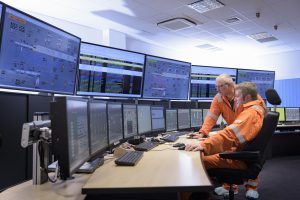Part 1: Know your starting point
This blog series is about training for a marathon and how a less-than-athletic, self-proclaimed sustainability & intelligent energy evangelist relates energy waste to sore limbs.
So, I’ve committed to run a marathon. The Paris, France marathon in fact. A 42.6km (26 mile) jog that winds its way past Notre Dame, the Louvre museum, and the Eiffel Tower.
Yeah right! Let me take the perfume off of the pig and tell you about my first run in ten years.
I woke up early on a Sunday morning and laced up my tennis shoes thinking, “Hey, I’ve run in these shoes before, let’s see how 5km feels on the legs.” It was a sunny Victoria, British Columbia October morning and running along the sea wall felt good – almost too good. I made it back home in 30 minutes and was pretty proud of myself. However, the problem came the next morning. My alarm clock went off but my legs no longer seemed to be responding. I could barely get myself from my bed to the kitchen. My leg muscles felt like a ball of tightly wound elastics. I had overextended myself and was now paying the price.
My “recovery” took longer than two days. After 3 days as a couch potato I was beginning to question the idea of running. What in the world was I thinking when I agreed to sign up for a marathon in a country where I barely spoke the language? Heck, when I fall by the side of the road, even if the doctors are able to revive me, I still won’t know what they’re saying! But, by the 4th day, my legs began to feel normal again and I was telling myself I had to get back out there.
This time, I got wise. A few internet sites convinced me that it was a dumb idea to run long distances with tennis shoes. In hindsight, I can’t believe that I thought tennis shoes, which are meant for quick starts and stops across a flat surface, would suffice – after all, the main impact of running on my body is my feet hitting the pavement for an extended period of time – in the case of a marathon, 4 straight hours or so.
That first running encounter reminds me of what an individual, corporation or other energy consumer goes through the first time they want to be more energy efficient. Some may take small steps like switching to high efficiency light bulbs. Others may draft a comprehensive energy management and sustainability plan. Most energy consumers, however, are somewhere in the middle. For the most part, they don’t know what they don’t know. So where do you start?
Similar to how I learned that I needed proper running shoes for marathon training, energy consumers who want to be more intelligent with their energy use need establish a logical starting point. Progress towards any goal, whether it be energy savings or running a long distance, can only be determined if you first take an inventory of your “start position”. For larger energy consumers, contacting an expert in energy efficiency to begin a conversation and pursuing an energy audit to establish a benchmark is always a prudent first step. For smaller energy consumers (individuals and families) many organizations offer practical advice and guidance via the internet (e.g., blogs like “5 Ideas to make your House Smarter“, government organizations like the U.S. Department of Energy and even Wikibooks offers simple tips to name a few). Simply searching ‘how do I make my home more energy efficient?’ in Google will produce many websites and forums offering information. As with any internet research, information from trusted advisors should be pursued and it’s always beneficial to cross check information from several sites.
Energy experts are in a unique position to support organization seeking energy management and sustainability guidance. These organizations focus 100% of their time assisting clients to optimize their energy systems and in some cases have helped them reduce their energy consumption by 30%; which inherently means a 30% cost savings.
Schneider Electric is this year’s sponsor of the Marathon de Paris, a world class race with over 40,000 runners that will take place on April 6, 2014.
If you’re interested in how my training went, here’s part 2 – Running a Marathon or a Business? How Technology impacts the Success of Both
In this blog series, I will share some of my personal experiences in preparation for this momentous event. I will also be sharing some juicy tidbits on what “intelligent energy” really means and how best practices can really help to save you money. This blog series can be found by searching “#ParisMarathon2014” in the search field (top right of the blog site) or by looking up ‘Nick Blandford’ in the bloggers directory to discover all blog posts I’ve published including this series. I can be found on twitter (@nickblandford) and most of my training runs have been recorded under ‘Nick Blandford / Victoria BC’ on Strava, which is a free app that lets you track your runs via a mobile device and helps you analyze and quantify your performance.
Are you going to be at the Marathon de Paris? Have you trained for a marathon? Feel free to share your experiences below.



Conversation
Hey Nick,
I look forward to reading more of your adventures!
Keep running!!
Olivier